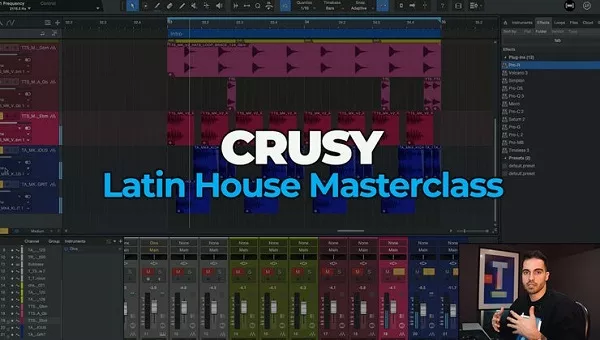
Latin House Masterclass w/ Crusy TUTORIAL
Join the Spanish producer and DJ for a colossal journey into Latin House production. In this course, Crusy takes us all the way from tribal sound selection and placement to a full mix.
The Spanish wunderkind started his own production journey as a teenager, and is now a Toolroom regular and Beatport Top 10 accolite. This course reveals the reasons behind his esteemed reputation as he constructs the track from barebone foundations, crafts a dense and heavy-hitting rhythm section and shapes the arrangement with interchanging focal points.
Over this 6-hour monster course, Crusy shows every facet of his production experience, starting by selecting, editing and layering percussive samples to make a vibrant, compelling rhythm. Next he spices things up with sub bass and vocal chops, exposing his sound selection methods along the way; and he completes the circle by spinning all his elements into an entire track. But he doesn’t stop there – Crusy continues by shaping an entire DJ-friendly arrangement to increase the track’s chances of success in the club, and creates compelling transitions between sections. As if that wasn’t enough, he then goes on to mix the entire track to a professional standard that works in all listening environments.
Crusy skillfully arranges and mixes his tracks in Studio One. In this course he highlights the effectiveness of his preferred stock plugins, such as X-trem and the Bitcrusher. When crafting the arrangement, he leans on his old faithful FabFilter Pro Q for key detection and filtering, Valhalla for spatial sound design and Cable Guy’s ShaperBox 2 for sidechaining. In the mixdown stage, Crusy unleashes the full power of his plugins library with software from brands like Plugin Alliance and Waves.
Spanning an expansive twenty chapters, this mammoth course sees Crusy meticulously dissect his production process, revealing the art of crafting infectious Latin House music that energizes dancefloors with vibrant tribal breaks. Take this in-depth course at your own pace and bring Crusy’s concepts to your own electronic music.
Prepare to begin a creative journey into Latin House, gaining first hand insights into Crusy’s experience and expertise in constructing dancefloor-ready hits.
Latin House Masterclass w/Crusy
- Chapter 1: Introducing the Course
Crusy introduces his production course covering his process of composing, mixing and arranging Latin House music. - Chapter 2: The Principles of Latin House
Crusy explains what he’ll cover in this course, and divulges key elements of Latin house sound design, groove, arrangement and mixing. - Chapter 3: Building Organic Latin House Percussion
Crusy constructs a groove by splicing, layering and rearranging percussion loops and finds the track’s tonal center with sub bass. - Chapter 4: Shaping Low End
Crusy creates the perfect 4/4 kick by crossfading specific attacks and kick tails, then sidechains the bass so both elements can coexist. - Chapter 5: Locking in the Groove
After introducing repitched and stretched one-shots, Crusy consolidates the groove using low-pass filtering, panning and drum bus treatment. - Chapter 6: Adding High-Frequency Information
Utilizing a separate bus for high-frequency percussion, Crusy crafts textural noise layers with band-pass filtering and heavy compression. - Chapter 7: Layering Hi-Hat Samples
Crusy stacks three hi-hats, adding body, snap and tonal movement to the pattern. Bus compression and clipping tightens the hat loop. - Chapter 8: Designing Bass
Crusy recreates the bassline to his track El Beso and highlights the importance of sustained notes, noise, filter distortion and pitch bends - Chapter 9: Percussive Bass Ideas
Crusy builds snappy bass lines with two methods: one with u-he Diva and one using repitched, keyboard mapped tom one-shots. - Chapter 10: Introducing Melodic Hooks
Crusy shares his philosophy on integrating melodies into an arrangement and offers examples of his favorite Latin House arrangements. - Chapter 11: Producing Realistic Timbale Drops
Crusy builds a powerful and humanized timbale break with distorted tails, dynamic clipping and tonal shaping. - Chapter 12: Adding a Timbale Break
Crusy composes a timbale break to the previously constructed groove, sub bass and hat pattern. - Chapter 13: Writing a Vocal Hook
Cursy chops vocal samples, arranges them into a hook and uses distortion, formant adjustment and delay processing to add character. - Chapter 14: Working with Vocalists
Cursy discusses building chemistry with vocalists to write meaningful music and explains the importance of shaping vocal samples to taste. - Chapter 15: Making Atmospheres and Impacts
Crafting atmospheres from printed decay tails, Crusy employs sidechaining and filtering for subtle movement low in the mix. - Chapter 16: Starting the Arrangement
Crusy starts arranging the track, showing how to prepare a project for arrangement and then adding transitional touches. - Chapter 17: Breaking Down and Building Up
Crusy strips the track’s elements back to a breakdown section, then brings things back to a build-up, talking through his decision-making. - Chapter 18: Finalizing the Arrangement
Crusy continues working his way through the arrangement, including the all-important drop, and crafts on a DJ-friendly intro and outro. - Chapter 19: Mixing and Clipping
Prepare for an onslaught on mixing wisdom as you witness Crusy divulge his hard-won knowledge of EQ, compression, clipping and more. - Chapter 20: Outro
Crusy sums up the main part of this course before we move onto further content.
